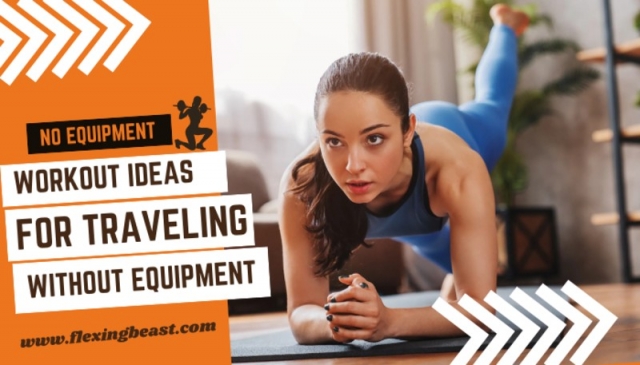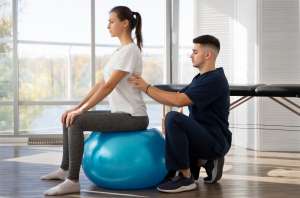It's simple to become engrossed in the weight room and believe that strength training is limited to lifting big objects. The fact is that you may increase your strength, balance, and mobility using a variety of full-body workouts that you can perform without any special equipment. Workout ideas for traveling without equipment according to Christine Torde, NASM-certified personal trainer and coach at Body Space Fitness in New York City, bodyweight-only exercises and training programs may be beneficial and challenging for people of all fitness levels.
Beginners and even seasoned exercisers attempting a new motion for the first time may benefit greatly from bodyweight exercises. When you add resistance, perfecting the form without weights will make it safer and more effective. However, as you improve, bodyweight exercises should be added. According to NASM-certified personal trainer and group fitness teacher Or Artzi, using bodyweight exercise may keep things intriguing and help you perform at your best. The nicest thing is how simple it is to advance and regress each action, which allows you to explore and experiment in infinite ways.
15 Workout Ideas For Traveling Without Equipment
Routine for beginners.
These ten basic bodyweight exercises will work your entire body. Perform each exercise in two sets of ten to fifteen repetitions, resting for 30 to 60 seconds in between. This circuit is an excellent starter program that should last 15 to 20 minutes.
Read also: Workouts To Get Faster In Sprints
1. Hold the jackknife hollowly.
An intermediate to expert-level abdominal exercise that works your core muscles is the hollow body hold. This exercise is great for athletes since it concentrates on maximal tension via the abdominal muscles due to the effort needed to drive the lower back onto the floor.
Benefits:
- Great for Both Beginners and Advanced
- Better Spinal Stability
- Improved Performance with Other Complex Exercises
- Improved Core Strength
Tips:
- Stretch your arms over your head while lying on your back. Lift your upper body and legs off the ground and keep them there by using your core.
- Raise your legs while keeping them fully extended, then lift your arms above until they meet your toes.
- Return to the engaged hollow hold posture by lowering your arms and legs gradually.
2. Side plank with hip abduction
How should you feel? When done properly, you'll feel your glutes and the muscles on the outside of your hips contract. Additionally, you will sense the muscles on the below of your trunk holding your upright posture.
Benefits:
- Equally strengthens three muscular groups.
- keeps your spine safe.
- without putting undue strain on your back, strengthens your core.
- Enhances your equilibrium.
- lowers your chance of suffering a back injury.
Tips:
- With your feet placed on top of one another and your legs straight, lie on your right side.
- With your hand balled into a fist and your forearm facing away from you, place your right elbow beneath your right shoulder.
- Your hand should be touching the ground with its pinky side.
- Breathe out and brace your core while keeping your neck neutral.
- To balance your weight on your elbow and the side of your right foot, raise your hips off the mat. From your ankles to your head, you should form a straight line.
3. One-leg forearm plank hold
It can feel like a lifetime endeavor to develop a strong core. There are other reasons to work on your core even if your abs aren't visible. Building a strong core can enhance stability and help avoid back problems, according to the Centers for Disease Control and Prevention.
Benefits:
- Planks can help improve your posture.
- Planks activate more muscles.
- Planks can help increase your flexibility.
- Planks are easy to modify.
Tips:
- As if you were going to perform a push-up, place your hands just behind your shoulders, slightly wider than shoulder width.
- To stabilize your body, press your toes into the ground and clench your glutes. Always move your legs and avoid locking or overextending your knees.
- Look at a point on the floor approximately a foot away from your hands to neutralize your neck and spine. Make sure your head and back are aligned.
4. Kneeling squat with jump
A lower body plyometric exercise, the kneeling squat jump will assist in building power, strength, and coordination in the muscles of the core, shoulders, arms, and spinal erectors, as well as the posterior chain, which includes the hamstrings, glutes, and low back.
Benefits:
- Increases lower body strength and power
- Improves explosive jumping ability
- Engages core muscles for stability and balance
- Can be modified for different fitness levels by adjusting the depth of the squat and the height of the jump.
- Provides a cardiovascular workout
Tips:
- Start by kneeling on the ground with your feet flat on the floor and your toes pointing forward.
- Place your hands on your hips or behind your head.
- Use your core and glutes to jump high and explosively.
- As you jump, extend your hips and knees fully.
Read More: Best Workout To Improve Vertical Jump
5. Elevated pike pushups
After standing on that item and placing your hands on the ground, poke your hips. Reach your elbows back towards your body while bending them. Return to your starting position by pressing up. To get the elbows to bend back in the proper direction, the shoulders must extend in front of the hands.
Benefits:
- It strengthens the shoulders.
- Trains the Triceps
- Builds Core Stability
- Improves Muscular Endurance
Tips:
- Begin in the same position as regular pike push-ups. Place your hands on either push-up supports or dumbbells.
- Lower yourself until your upper arms are parallel to the floor.
- The deficit allows you to go a deeper range of motion.
- Return to the starting position and repeat for the specified number of sets.
6. Jumping lunges
Jumping exercises, sometimes referred to as plyometrics, call for exerting maximum effort for brief periods of time. You will experience the burn rapidly because of the strength and force they demand. To push yourself, incorporate a leap into your lunge that truly pops up with each repetition.
Benefits:
- Weight loss
- Balance and stability
- Alignment and symmetry
- Stand taller
- Stationary lunges
Tips:
- Always do warmup exercises or quick core workouts to avoid injury.
- Initially, do it slowly, then gradually increase the speed.
- Rest in between the jumps.
- Do not stretch the forward knee beyond your foot, as it increases the knee pain.
- Do not lock your knees, as it may create problems while landing.
7. One-legged pushup
Bend your elbows and bring your body down toward the floor until your chest is about two inches above the ground while maintaining a raised right leg. Lower your right leg to the floor after pushing your body back to the beginning position. With the left leg up, repeat the movement.
Benefits:
- Improving balance and stability
- Strengthening lower body muscles
- Increasing functional strength
- Improving flexibility and mobility
Tips:
- Stand with one hand resting on a sturdy surface, such as a countertop or table.
- Lift one leg off the floor so that your foot reaches slightly behind your body.
- Bend through your knee as you lean your chest slightly toward the floor.
- Hold the squat for a few seconds, then push through your foot to straighten your knee and return to standing.
8. Single-leg bridge with legs extended.
A great addition to a core-and-glute exercise program is the glute bridge. Additionally, you may increase the difficulty of the exercise with this variation! Everything you need to know about the bridge with leg extension is right here, along with helpful exercise benefits, an easy-to-follow video, and directions.
Benefits:
- Increases hip-extension strength
- May improve sports performance
- May help prevent injuries
Tips:
- Lie on your back with your knees bent and feet flat on the floor.
- Lift one knee to a tabletop position.
- Press through the foot that is flat on the floor to lift your hips off the ground. Try to keep your hips square while squeezing your glutes to help you lift.
- Pull your abdominal muscles in to prevent your back from arching.
- Return to your starting position.
9. A dead bug
You only need your own weight to do the workout; no further equipment is needed. Keeping your core muscles active, you must raise and lower your opposing arms and legs while resting on your back. The exercise has been aptly termed "dead bug" since the position mimics an insect on its back.
Benefits:
- Promotes Mindfulness
- Improves Cross-Crawl Patterns
- Strengthens Your Core
- It allows for full breaths.
- Promotes spine stability.
Tips:
- With your arms out in front of you and your legs on the tabletop, begin reclining on your back.
- Make sure your lower back remains level on the ground as you drop your right arm above your head and the heel of your left leg toward the ground in a synchronized action.
- Repeat with the opposing arm and leg after returning your leg to the tabletop and placing your arm in front of you.
Read also: Core Circuit Workouts: Your Path to a Stronger Core
10. Kneeling side plank with hip abduction
Improving hip strength and stability is a crucial component of any training program, whether it be general or remedial. Knowing which exercises result in the most muscle activation is crucial because training periods are short.
Benefits:
- Boosts the power and strength of the lower body
- Enhances the capacity for explosive leaping
- uses the core muscles to provide balance and stability.
- May be altered to accommodate varying levels of fitness by changing the jump's height and the squat's depth.
- Gives you a cardiovascular workout.
Tips:
- To begin, kneel on the floor with your toes pointed forward and your feet flat on the floor.
- Put your hands behind your head or on your hips.
- Jump as high as possible with explosive glute and core activation.
- Fully stretch your knees and hips as you jump.
conclusion
Expensive gym equipment is not necessary to stay active when traveling. Wherever you go, you may maintain your fitness regimen with basic bodyweight exercises and inventive use of your environment. There are countless options for outdoor exercises in parks or beaches, as well as quick circuits in hotel rooms. Maintaining consistency and modifying your workouts to suit your schedule and surroundings are crucial. These workout ideas for traveling without equipment demonstrate that it is possible to stay fit and healthy when on the trip. Thus, include movement in your trip experiences, pack your willpower, and use your imagination. In addition to feeling amazing, being in shape while traveling gives your adventure more vitality!






